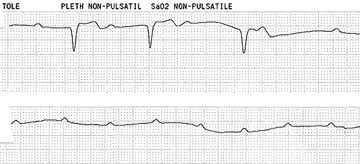Country cardiograms case 7:
Hugh R. Hindle, MB BS, CCFP
Complete atrioventricular block associated with inferior myocardial infarction
Hinton Medical Clinic, Hinton, Alta.Can J Rural Med vol 3 (1):38
This paper has been peer reviewed.© 1998 Society of Rural Physicians of Canada
Findings
The ECG shows complete atrioventricular (AV) block indicated by dissociation of the P waves from the QRS complexes. Slightly widened junctional escape beats activate the ventricles. Q waves and ST elevation in the inferior leads suggest a recent inferior infarction, confirmed by a raised creatine kinase level. The patient subsequently remembered a few hours of severe "heartburn" 2 nights before.

What I should have done was to apply transcutaneous pacemaker pads, made sure that electrical capture was possible and arranged transfer for consideration of urgent transvenous pacing and angiography. However, lulled by his apparent stability, I admitted him to our hospital. By this time the patient needed to void. With the curtains drawn around him the following display appeared on the monitor.
The now unconscious patient responded promptly to atropine and was rapidly transported to a tertiary care hospital. He required transcutaneous pacing intermittently during transfer. Subsequently a transvenous pacemaker was necessary. Angiography showed critical circumflex disease requiring angioplasty and stenting. Normal AV conduction resumed after 10 days and he eventually made a good recovery.
Complete AV block is a common complication of myocardial infarction, occurring in 10% to 12% of patients with inferior infarctions and half as frequently with anterior infarctions.1 AV block associated with anterior infarction is usually secondary to extensive myocardial necrosis; consequently death rates approach 50%.2
Ischemia of the AV node, due to occlusion of the right coronary artery or, less frequently, the circumflex artery, causes complete AV block with inferior infarction. Generally the block is transient, the escape pacemaker reliable and any bradyarrhythmias respond well to the administration of atropine.3 Reflex vagal activity, frequently seen with inferior infarction, is also important in the development of complete AV block. The intense vagal stimulation of micturition precipitated asystole in this patient.
Although complete AV block associated with inferior myocardial infarction usually resolves spontaneously, it should not be regarded as a benign condition. Temporary pacing is necessary in 60% of patients and in-hospital death rates are 3 to 4 times higher than they are for inferior infarction without complete AV block. Much of the increased mortality can be explained by an association with larger infarct size, but complete AV block is independently associated with a twofold increase in death rates.1,2 Next time I will call for the plane right away!
References
- Goldberg RJ, Zevallos JC, Yarzebski J, Alpert JS, Gore JM, Chen Z, et al. Prognosis of acute myocardial infarction complicated by complete heart block (the Worcester Heart Attack Study). Am J Cardiol 1992;69:1135-41.
- McDonald K, O'Sullivan JJ, Conroy RM, Robinson K, Mulcahy R. Heart block as a predictor of in-hospital death in both acute inferior and acute anterior myocardial infarction. Q J Med 1990;74(275):277-82.
- Reeder GS, Gersh BJ. Modern management of acute myocardial infarction. Curr Probl Cardiol 1996;21(9):585-667.